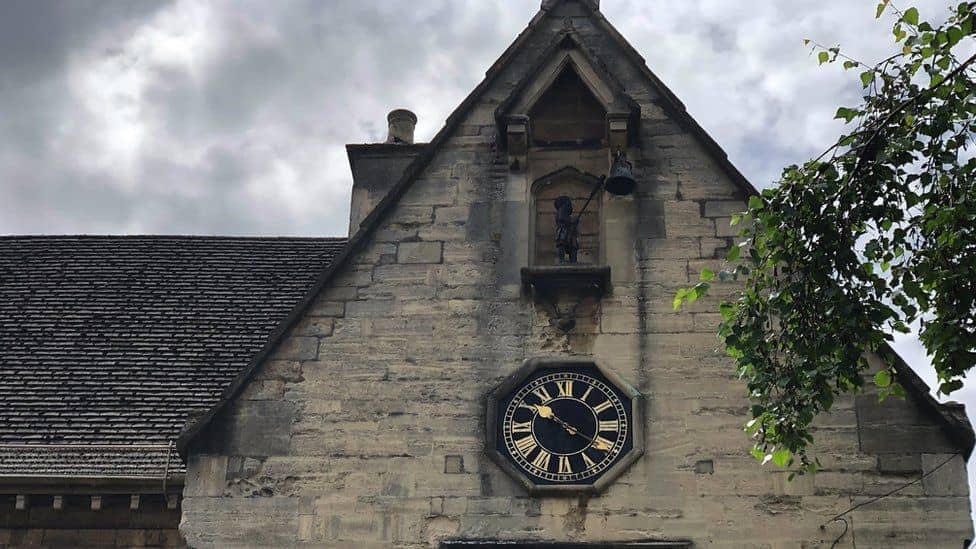Britain’s statue wars are rumbling on. Stroud District Council wants to take down an historic Jacquemart or jack – a mechanised figure which strikes the time with a hammer on a bell – clock located on Castle Street in the centre of the Gloucestershire town. Whilst jack clocks are fairly common in France and Germany, there are only 20 in the UK, most showing knights or similar striking the bell. Stroud’s jack, however, is a thick-lipped black boy in a leaf skirt and hence offends today’s mores.
In the aftermath of the 2020 Black Lives Matter protests and Bristol’s Edward Colston statue being toppled by a mob and thrown into the harbour, Stroud District Council – run by a coalition of 15 Labour, 13 Green and three Liberal Democrats councillors – decided that action needed to be taken. So in time honoured tradition, the Council set up a review panel.
The panel – chaired by a Labour councillor and including various community representatives and a self identifying ‘radical’ historian – has now recommended that the clock and statue be removed at a cost of £33,500 to local taxpayers and be placed in a museum. The Council will be making their decision on Thursday and it appears that it will endorse these conclusions as they are backed by the ruling coalition. Thankfully, whether they will be implementable is another matter.
The 1774 clock is not a great work of art, but rather an expression of vernacular craftsmanship. It is the creation of John Miles, an obscure eighteenth century Stroud clockmaker whose work is not prominent in our museums and rarely comes up for auction; in 2008 one of his mechanisms for a grandfather clock sold at Christies for £1,000. Nevertheless, it is deeply rooted in Stroud – indeed it is much more specific to its locality than many more accomplished works of public art – and has been a local landmark for nearly 250 years.
Miles owned a shop on Stroud’s High Street and the clock stood above its entrance. A 2021 expert report on the clock’s significance commissioned by the Council notes: ‘It would have been a significant and well-known feature in the commercial heart of the town.’ The clock then spent some years in the nineteenth century adorning a local pub, the Duke of York. The people of Stroud had got so fond of the clock by 1844 that it was bought via a public subscription scheme, the crowdfunding of its day, and placed on the front of the then new National School for Girls in a niche designed for this purpose. This is where it still stands. The girls’ school, which came to be known as Blackboys, closed in the 1960s and was eventually converted into five flats in the 1990s. The clock was restored in the 1970s – the Black Boy figure is made of wood and its head was rotten – and again in 2004. On neither occasion were questions raised about its appropriateness. It was then just seen as a quaint and unusual historical curiosity.

As the Council commissioned report acknowledges, there is no evidence that the statue is meant to be of a slaveboy: ‘It has been mooted that the boy is a depiction of a slave; this cannot be verified.’ The Pevsner guide for the Cotswolds suggests that the Jack clock was an advert for tobacco, but since Miles’s shop did not sell tobacco it seems more likely that it is just a shop sign illustrating his proficiency as a clockmaker and luring the public to go in and sample his wares.
Stroud’s Blackboy should perhaps be seen as an early precursor of the stereotyped and slightly racist advertising logos with which we now feel uncomfortable – such as Robinson’s Jams’ gollywog, Uncle Ben’s elderly bow-tied black man (removed in 2020) and Austria’s ubiquitous Meinl coffee’s Moor boy in a red fez (only removed late last year). It is doubtful if these brands did actually reinforce stereotypes – most sane people can tell the difference between a highly stylised image of a Moor in a fez on a coffee cup and an actual real life Arab boy – but a strong case can be made for their removal from packing on the grounds that the mass replication of such images is in poor taste in the twenty-first century. Corporate brands – at least in the case of Uncle Ben’s and Meinl – were until now still replicating these images in their millions. No one is today banging out Stroud Blackboys – indeed they never have been. Removing the jack clock would be analogous not to ceasing the use of these logos but expunging them from the record.
One gets a flavour of the Council panel’s deliberations when their report states: ‘The Panel also considered the demographics of the district noting that the population is becoming increasingly diverse with an increase of 64 per cent in the Black and Minority Ethnic population between the 2001 census and the 2011 census.’ As the report’s tables acknowledge, Stroud remains 97.9 per cent white. The district’s population in 2011 included 260 people defining themselves as ethnically Black African or Black Caribbean, and over 110,000 defining themselves as White.
In what has now become the fashionable way of doing things, the Council conducted an online consultation on what should happen to the clock and its Black Boy. Of its 1,680 responses, 58 per cent wanted it removed to a museum, 22.5 per cent wanted it to remain in place and 20 per cent wanted it to be destroyed. Thankfully destruction ‘was ruled out as being unfeasible by the Panel’ (note such iconoclasm was not ruled out for being wrong, but merely impractical).
The problem with the consultation is that the respondents are self selecting; such surveys can easily be gamed by campaigning groups on either side and it is impossible to know if they are representative of feelings in Stroud as a whole; indeed they are very unlikely to be as those with the strongest opinions are most likely to respond.
So will Stroud’s Blackboy fall? This is very far from certain. Blackboy House – on which our jack is perched – is Grade II listed. The removal of the clock and statue will need Listed Building Consent. Due to rules introduced in 2021, if Historic England objects – which is very likely as the pre-application advice they have given to the Council at its request is highly sceptical of the case for removing the Black Boy – the final decision will be made by the Secretary of State for Levelling Up, Housing and Communities, currently Michael Gove.
Even this presupposes that the owners of the clock and statue agree to its removal. Unlike much public art the council does not own the jack. The Council at first thought that the ownership was with the five flatowners of Blackboy House. Whilst expressing mixed emotions, they have agreed to support the clock’s removal and rename the building – if the Council picks up all costs. But they don’t own jack either. He is owned by the seemingly moribund Blackboy Clock Trust set up 20 years ago to apply for grants for the restoration of the clock.
This suggests there is a way to ensure that Stroud’s Blackboy rightfully remains on his much deserved perch. If the Blackboy Clock Trust could be persuaded to sell the clock to a new trust whose specific purpose was to preserve the jack in situ in perpetuity, no route for its removal would remain open. It would be safe from the vagaries of politics and faddish sentiment. In 1844 the people of Stroud clubbed together to save their jack; perhaps that endeavour needs to be repeated once more.






Comments